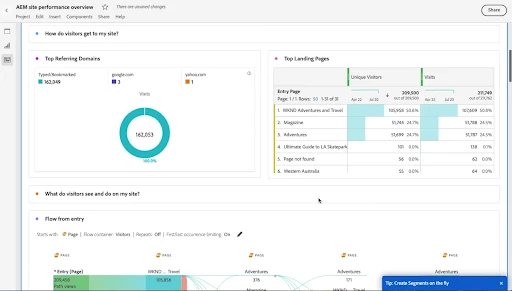In 2022, the Adobe community released a series of updates for Adobe Experience Manager (AEM) and related products, aiming to address enterprise needs around content and digital asset management. In this release, the community identified the main areas for improvement: personalization, automation, omnichannel content delivery, advanced analytics, and security. This blog post looks into new AEM features and enhancements delivered with the latest update.
Integration with Adobe Learning Manager
Adobe Learning Manager (ALM), formerly known as Adobe Captivate Prime, is a learning management system powered by Artificial Intelligence (AI) that helps to create personalized, flexible, and feature-rich user interfaces adaptable to multiple devices.
After a new release in August 2022, AEM Sites was integrated with ALM introducing a bunch of out-of-the-box functionality. With the integration, it is now possible to create learning portals with responsive user interfaces, employing little to none coding effort.
Adobe Learning Manager was originally integrated with a range of Adobe Experience Cloud products. Thus, the ALM integration with Adobe Marketo Engage helps marketing specialists to create personalized campaigns with informational or promotional content based on user actions on a learning portal. Adobe Commerce allows to monetize in-house courses and training, as well as securely manage payments.

Join the upcoming Adobe Learning Manager Summit 2022 held on October 5–6 in Las Vegas. The industry experts will share their experience in implementing Adobe Learning Manager into in-house workflows and designing learning strategies for employees, partners, and customers.
Delivering an agile customer experience
AEM Sites is an AI-driven content management system that promotes the ease of creation and managing websites on any device of choice. The update introduced the AEM Sites integration with Commerce Integration Framework, an add-on AEM module that provides the necessary tooling to accelerate integrations between AEM and commerce solutions. This will enable AEM customers to deliver an efficient omnichannel shopping experience on a single platform.

In addition, a modern image format, WebP, is now available in AEM. The format allows for lossless web image compression and fast image download without affecting quality.
Enabling data-driven insights
Capturing analytics of an AEM-based portal has never been easier. The Experience Cloud Setup Automation function allows to automatically integrate and configure AEM Sites and Adobe Analytics. With an easy-to-navigate monitoring panel, it is possible to derive valuable insights on end-user engagement and conversion rates in just a few clicks.

The Experience Cloud Setup Automation is available out-of-the-box with AEM Site built using AEM Core Components and Adobe Client Data Layer. Users can automatically create websites with these features enabled, using AEM Project Archetype. Alternatively, users can opt for AEM Site templates to build new websites.
Creating content at scale
In Adobe Experience Manager Assets, it is now possible to set limitations on the type of downloaded files and media. This feature will prevent malicious file upload, enforcing security.
With the newly introduced reporting option, users can create and manage reports to review any user interaction with platform content. A live statistics dashboard provides visibility into user activity (downloads, uploads, and storage usage), making it easier to analyze and drive informed decision-making.

Adobe Experience Manager Forms now supports Scribble signature keyboard input. When a user enters a name with a keyboard, it gets automatically converted into a Scribble signature in a document. This improves platform accessibility and compliance with e-signature standards.
In addition, the Workflow step was added in Adobe Experience Manager Forms. The feature automates the generation of PDF documents, reducing the creation time to seconds.
Thanks to improved integration with Adobe Campaign, marketing specialists can launch and coordinate e-mail marketing campaigns in AEM Sites directly. With ready-to-use marketing templates, specialists can easily create personalized and consistent e-mail campaigns while also following established brand guidelines.
Accelerating time to value
AEM as a Cloud Service is now integrated with Unified Shell to ensure a unified user experience across Adobe Experience Cloud products.

The integration brings about the following benefits to users:
- single sign-on across Adobe Experience Cloud apps: AEM as a Cloud Service, Adobe Target, Adobe Campaign, and Adobe Analytics
- ease of navigation between organizations and apps on a single dashboard
- the Report button to submit issues, share ideas, and get developer feedback
- access to global product announcements and notifications
AEM as a Cloud Service has Unified Shell enabled out-of-the-box. In case the AEM user interface has been previously customized, though, you can disable the Unified Shell feature to prevent arising issues during customization. The step-by-step instruction on how to disable the Unified Shell function can be found in this article.
Interested in how your business can benefit from the Adobe Experience Manager platform? Contact us, and we will identify your needs, define potential challenges, and outline a roadmap for implementation.
